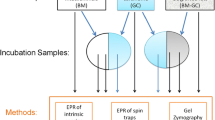Summary
Following CPIB treatment one or more double-walled tubular structures, measuring 110 μ in diameter, were observed in the hepatic microbody profiles in hypophysectomized rats, as well in rats bearing liver tumors. These tubules appeared as straight rigid rods of considerable length and were oriented irregularly within the microbody profiles. Examination of several microbody profiles containing these tubules suggests that these structures may be formed as a result of transformation of microbody matrix protein(s). Varying degrees of electron lucency of microbody matrix and the size and shape of the channels containing these straight tubules are considered as further evidence to indicate that microbody proteins circulate within the endoplasmic reticulum channels.
Similar content being viewed by others
References
Beard, M.E., Novikoff, A. B.: Distribution of peroxisomes (microbodies) in the nephron of the rat. J. Cell Biol.42, 501–518 (1969).
Chiga, M., Reddy, J., Svoboda, D.: Degradation kinetics of liver catalase in rats treated with ethyl-α-p-chlorophenoxyisobutyrate. Lab. Invest.25, 49–52 (1971).
Dalton, A. J.: An electron microscopical study of a series of chemically induced hepatomas. In: Cellular control mechanisms and cancer, ed. by P. Emmelot and O. Mühlbock, p. 210–225. Amsterdam-London-New York: Elsevier 1964.
Hess, R., Stäubli, W., Riess, W.: Nature of the hepatomegalic effect produced by ethylchlorophenoxyisobutyrate in the rat. Nature (Lond.)208, 856–858 (1965).
Hruban, Z., Rechcigl, M., Jr.: Microbodies and related particles. Morphology, biochemistry and physiology. Int. Rev. Cytol., Suppl. 1.85, 117 (1969).
Hruban, Z., Swift, H.: Uricase; localization in hepatic microbodies. Science146, 1316–1318 (1964).
Hruban, Z., Swift, H., Slesers, A.: Ultrastructural alterations of hepatic microbodies. Lab. Invest.15, 1884–1901 (1966).
Langer, K. H.: Feinstrukturen der Mikrokörper (microbodies) des proximalen Nierentubulus. Z. Zeilforsch.90, 432–446 (1968).
Leighton, F., Poole, B., Lazarow, P. B., DeDuve, C.: The synthesis and turnover of rat liver peroxisomes. I. Fractionation of peroxisome proteins. J. Cell Biol.41, 521–535 (1969).
Pfeifer, U.: O-Mikrotubuli in fokalen Cytoplasmanekrosen von Leberepithelien und ihre Beziehung zu Mikrokörpern. Virchows Arch. Abt.B 2, 1–5 (1969).
Reddy, J., Bunyaratvej, S., Svoboda, D.: Microbodies in experimentally altered cells. IV. Acatalasemic (Csq) mice treated with CPIB. J. Cell. Biol.42, 587–596 (1969).
Reddy, J., Chiga, M., Bunyaratvej, S., Svoboda, D.: Microbodies in experimentally altered cells. VII. CPIB-induced hepatic microbody proliferation in the absence of significant catalase synthesis. J. Cell Biol.44, 226–234 (1970).
Reddy, J., Chiga, M., Svoboda, D.: Stimulation of liver catalase synthesis in rats by ethylα-p-chlorophenoxyisobutyrate. Biochem. biophys. Res. Commun.43, 318–324 (1971).
Reddy, J., Svoboda, D.: Microbodies in experimentally altered cells. VIII. Continuities between microbodies and their possible biologic significance. Lab. Invest.24, 74–81 (1971).
Reddy, J., Svoboda, D.: Microbodies in Leydig cell tumors or rat testis. J. Histochem. Cytochem.20, 793–803 (1972).
Reddy, J., Svoboda, D.: Further evidence to suggest that microbodies do not exist as individual entities. Amer. J. Path.70, 421–438 (1973).
Reddy, J., Svoboda, D., Azarnoff, D., Dawar, R.: Cadmium-induced Leydig cell tumors of rat testis: morphological and cytochemical study. J. nat. Cancer Inst. 1973 (submitted).
Shnitka, T. K.: Comparative ultrastructure of hepatic microbodies in some mammals and birds in relation to species differences in uricase activity. J. Ultrastruct. Res.16, 598–625 (1966).
Svoboda, D. J., Azarnoff, D.L.: Response to hepatic mrcobodies to a hypolipidemic agent, ethyl chlorophenoxyisobutyrate (CPIB). J. Cell Biol.30, 442–450 (1966).
Svoboda, D., Azarnoff, D., Reddy, J.: Microbodies in experimentally altered cells. II. The relationship of microbody proliferation to endocrine glands. J. Cell Biol.40, 734–746 (1969).
Svoboda, D., Grady, H., Azarnoff, D.: Microbodies in experimentally altered cells. J. Cell Biol.35, 127–152 (1967).
Tsukada, H., Mochizuki, Y., Fujiwara, S.: The nucleoids of rat liver cell microbodies, fine structure and enzymes. J. Cell Biol.28, 449–460 (1966).
Author information
Authors and Affiliations
Rights and permissions
About this article
Cite this article
Reddy, J., Svoboda, D. Microbody (Peroxisome) matrix: Transformation into tubular structures. Virchows Arch. Abt. B Zellpath. 14, 83–92 (1973). https://doi.org/10.1007/BF02889178
Received:
Issue Date:
DOI: https://doi.org/10.1007/BF02889178



